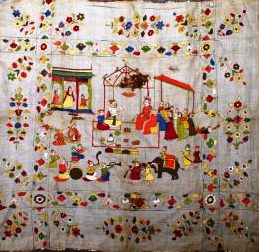
Art history/ Historiography, Museums/ Galleries / Collections / Exhibitions
The Transformation of the Kantha from Asceticism to Fashion
Pathak, Anamika
March, 2020
The word kantha (in Sanskrit), or kathari, kath and gudari (in Hindi), refers to a patched garment, a bag or a hold-all, traditionally worn or carried by ascetics. The word appears in most Sanskrit dictionaries, such as Gode's Sanskrit-English Dictionary (1957) or Apte's Sanskrit-Hindi Kosh (1966: 529) and was used by European scholars like Monier-Williams (1966: 244). In addition, the kantha and its. various aspects — its making, ethos and symbolism among others — have been discussed and written about by experts (Sen 1935; Mookerjee 1939: 11-14; Kramrisch 1939: 141-67; Chattopadhyay (1975); Dhamija 1971: 69-74; Zaman 2002: 237-46,2004).
In the early plastic arts, dated to the second century AD, there are similarities in the literary definition and description of the kantha and the representation of such attire. According to Gurusaday Dutt, the kantha originally comprised applique work done on quilts, which was later replaced by embroidery work (Chattopadhyay 1971: 76). However, most museum collections do not include specimens of either the patched garment or the appliqued kantha. The most widely known kantha specimens to be found in museums in India and abroad are mainly coverlets, bed-spreads, floor rugs, shawls, wraps, and covers for boxes and mirrors....
This is a preview. To access all the essays on the Global InCH Journal a modest subscription cost is being levied to cover costs of hosting, editing, peer reviewing etc. To subscribe, Click Here.



